SEO
Get These 6 Types of Backlinks (+ 4 Types to Avoid)
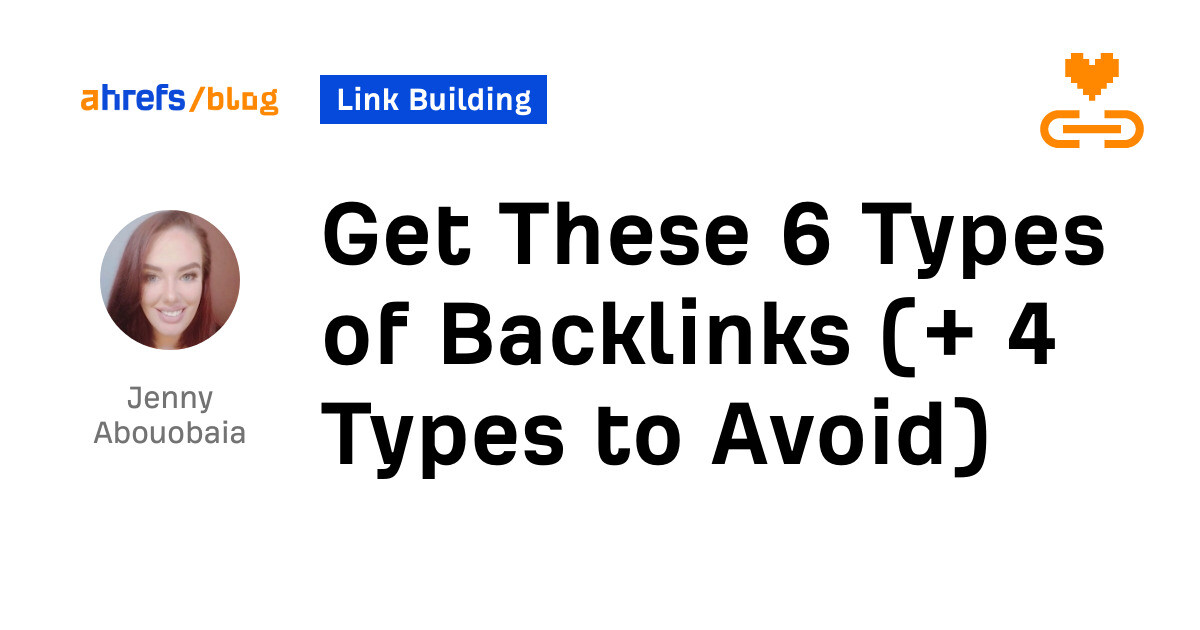
We all know that building links is crucial to any SEO strategy. The problem is that with so many link vendors and outreach specialists offering different types of backlinks, it can be challenging to know which links provide value and which you should avoid at all costs.
Because when it comes to building the wrong links, this can be a costly error that can seriously damage your site or, worse, a client’s.
This article will help you start your link building journey the right way. I will walk you through the six types of backlinks that will boost your SEO efforts and, more importantly, four types to avoid.
Although there are many types of backlinks in SEO, only some of those are worth taking the time and effort to acquire. Let’s take a look at some of the most popular types of backlinks and how you can land them.
1. Editorial backlinks
As someone who loves using digital PR for SEO, I guess it’s probably no surprise that editorial backlinks are at the top of the list.
Being cited within content as an authoritative source is one of the best links you can acquire. These can often come from high-authority sites and also drive tons of referral traffic.
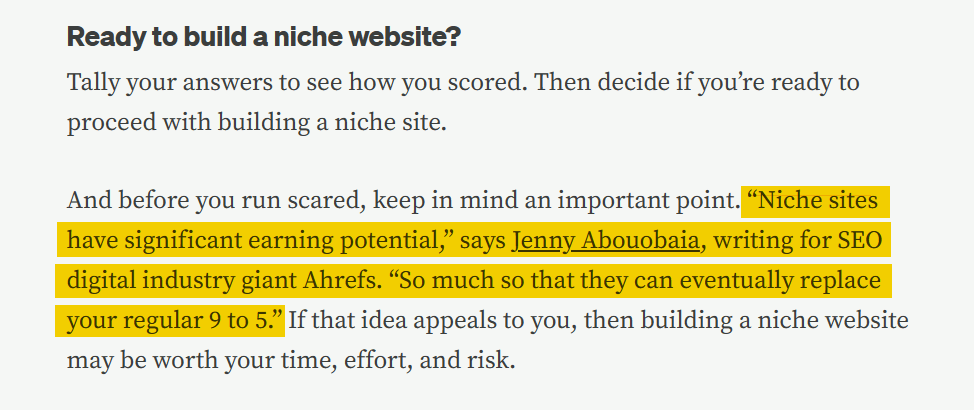
How it works
Create high-quality content that other sites will want to cite as a source and include linkable assets like infographics within your content that other sites will be keen to share.
Also, use PR techniques (e.g., newsjacking) or reactive PR with platforms (e.g., Help a Reporter Out, aka HARO), which allows you to be quoted as an expert source on a topic and achieve editorial links to your website.
2. Guest blogging backlinks
Most SEOs will build guest blogging links for every site they work on; in fact, it’s the most used tactic, according to Authority Hacker’s link building survey.

The only problem with these types of links is that most people don’t take the time to build them themselves. Most SEOs (unless working for an agency with an in-house link building team) outsource to others and, as a result, the links are often on low-quality sites.
These links are relatively easy to acquire, as it’s a win-win for both sites. Not only do you get an excellent backlink from an authority site, but they also get a quality piece of content that will drive traffic to their blog.
With these links, you must do your due diligence before reaching out to sites. Doing your own outreach also means building lasting relationships with web administrators and site owners that you can utilize repeatedly.
How it works
Find the perfect authority site to reach out to. You can easily do this by using Ahrefs’ Content Explorer, entering a keyword or phrase in the title, and filtering the results by Domain Rating (DR). This will help you find appropriate blogs already publishing related content.
In the example below, I have searched for the keyword “link building,” filtering results by DR 30–65. For new sites looking to build links, this DR range works well because it is high enough to move the needle, but not too high that getting a link from the site will be unrealistic.
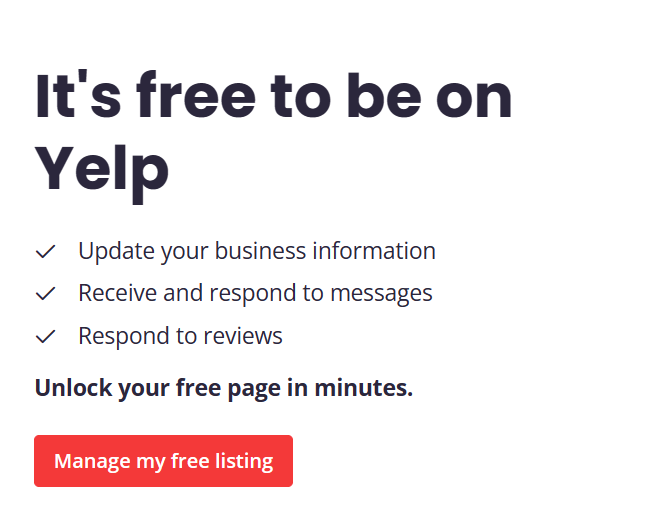
Once you’ve found relevant sites to reach out to, spend a little time doing some digging. Check a site to see what topics it has covered most recently. Also, be sure to check the quality of links in its backlink profile. I’ll expand on what to look for in a great backlink later on.
Use a tool like Hunter.io to find appropriate contacts for your chosen sites to start putting your outreach emails together.
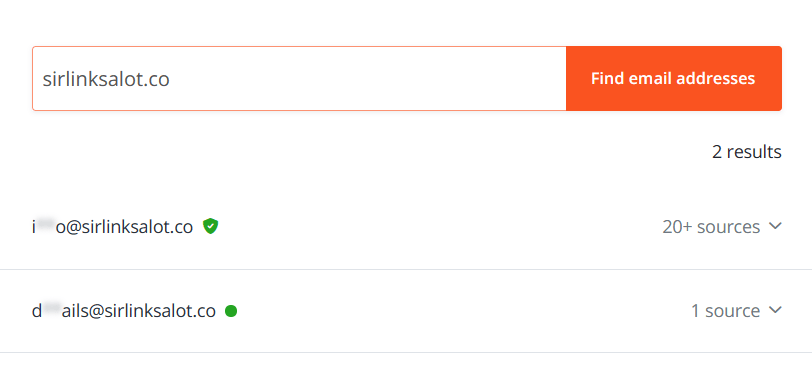
Now you can reach out and pitch them your topic ideas. Either pitch new topics relevant to their existing content and audience or check their sites for underperforming content and offer to produce an updated version.
In my experience, what works best is to put together a detailed content brief on two to three topics and send that over. This allows a site’s content team to get an idea of the article you are looking to provide and how much value it can add.
A detailed content brief should include the following:
- Title ideas
- Similar posts on the SERP
- The goal of the post
- Post format based on SERP intent (commercial, informational, listicle, etc)
- Target audience
- Three to five keywords, their search volume, and keyword difficulty
- “People also asked” questions
- Optimal word count
- Suggested outline and key points (including suggested headings for H2s, H3s, and H4s)
If you have an existing portfolio and following, include links in your email and inform them that you will be happy to share the content with your audience once it is published.
3. Relationship-based backlinks
Relationship-based backlinks could technically fall under editorial links. However, editorial links, as mentioned in the context above, are more organic and take less work to achieve.
Relationship-based links take time and effort to nurture, but they are worth it in the long run.
How it works
Reach out to journalists or web administrators who have already linked to you. Take time to thank them and state you are willing for them to contact you if they need any further input. This can be the first step in building ongoing relationships.
This works exceptionally well in digital PR. Once a journalist knows you are a trusted source of information open to being contacted directly, they are likely to reach out whenever they are working on something they feel you have insights on.
Here’s an example of a nice email I got from the team at ScaleMath after reaching out to them in regards to some expert commentary I provided for the blog:
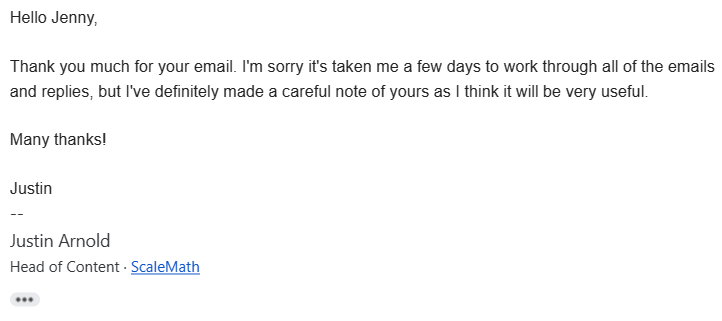
Another way to build relationships is by using three-way link exchanges. These types of links are working successfully across the globe, as shown in our recent article on international link building.
However, if these are done excessively and without proper due diligence on the sites you’re exchanging links with, they can be labeled as a link scheme. So take extra care when using this tactic.

4. Backlinks in business profiles
Building a digital footprint for your business will help search engines consider your website to be well established within your industry. A popular way of doing this is by creating business profiles.
How it works
You can create profiles on business listing websites like Crunchbase or InsiderPages that will include a link to your site. Most of these sites have a landing page that will allow you to go ahead and create a profile, each only taking a few minutes.

A word of warning, though: Be careful—too much of this is considered spammy and may not work for you. Using the biggest established listings as benchmarks, along with common sense, should be enough to separate the wheat from the chaff.
5. Backlinks from public speaking
Granted, these types of backlinks are not for everyone. But if you’re confident in front of an audience or even behind a microphone, participating in public speaking opportunities can be a fantastic way to earn quality backlinks.
These types of links are also a fantastic way to demonstrate the double “E” in experience, expertise, authoritativeness, and trustworthiness, or E-E-A-T.
How?
Because you’re building a digital footprint showing you’re experienced in speaking as a subject matter expert, which promotes you as a trusted authority in your industry.
How it works
You can earn these links through multiple events, including:
- Live seminars
- Webinars
- Podcasts
- Conferences
- Online courses
Being a guest speaker or instructor means your bit is often posted on the official website with a link so interested users can find out more about you and your experience.

6. Embedded asset links
This is one of my favorite lesser-known types of backlinks that not only works a treat when it comes to landing tons of placements but also serves as excellent brand exposure.
Embedded asset links can be broken into two categories:
Tools and widgets
It’s important to note that the first of these will only work in specific niches. However, if you work in a niche where this is possible, it’s a great way to score ongoing links with minimal effort.
How it works
You create a tool or widget on your site and make the code accessible for other website owners in your niche to embed the widget on their sites.
This works well with calculators, but do make sure your brand (and that all-important link to your site) shows as part of the tool. This numerology calculator from Affinity Numerology is a great example:

Awards and badges
The second embedded asset link is far more universal if you are creative. I’ve worked with everything from SEO agencies to niche affiliate websites where this technique was used successfully.
The fact is that most people love accolades. Being named the best at something, especially if it is by a reputable company within your industry, is something worth displaying to potential customers. This helps build trust, which is why this type of backlink is so easy to acquire.
How it works
You create a “best of” style roundup post on your site. You can do this yourself based on your own opinions. Alternatively, if you want to be authentic, you can run a poll on social media or via a tool like Pollfish to get public opinion on your chosen topic.
Then you reach out to the sites you have highlighted in your post and inform them they have been voted the best (at whatever the topic may be). You give them a badge (with your brand and a link to your site) that they can proudly display.
For example, here is a roundup of the “Best Business Blogs” from a U.K.-based SEO agency, Session Media:
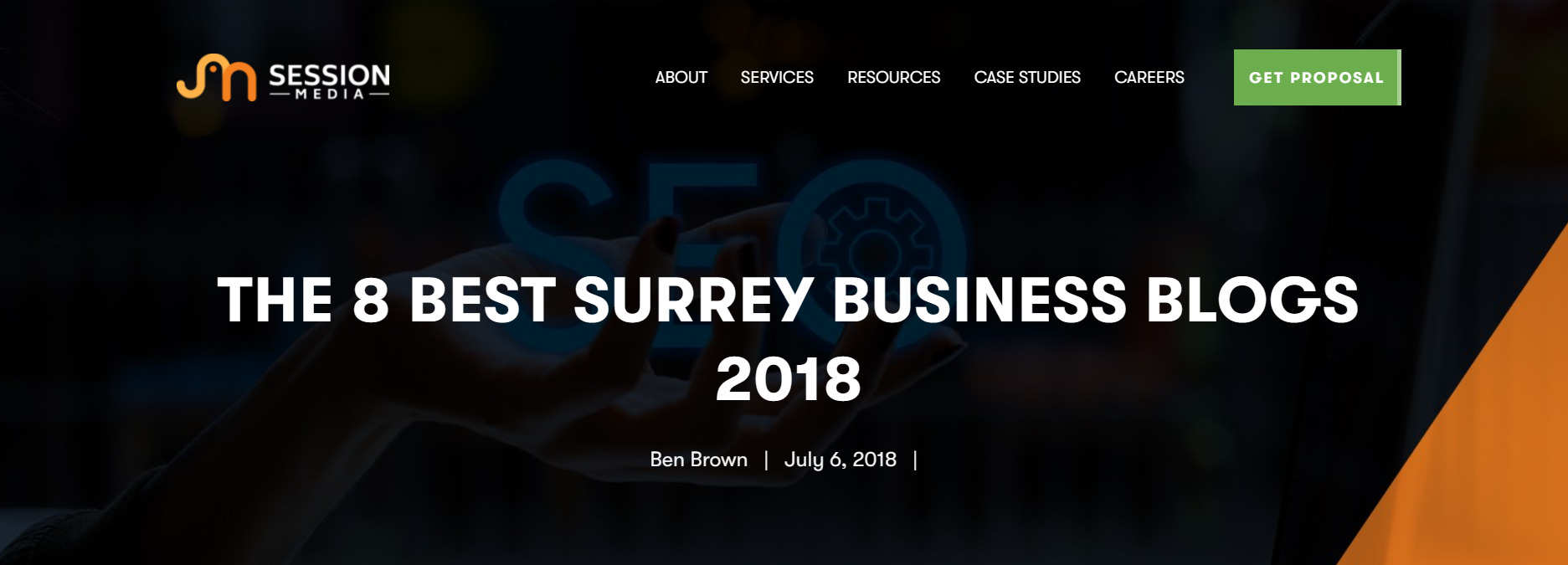
The agency lists its top choices, including “The Dad Blog UK,” which then proudly creates its own post to show off the shiny winner’s badge.
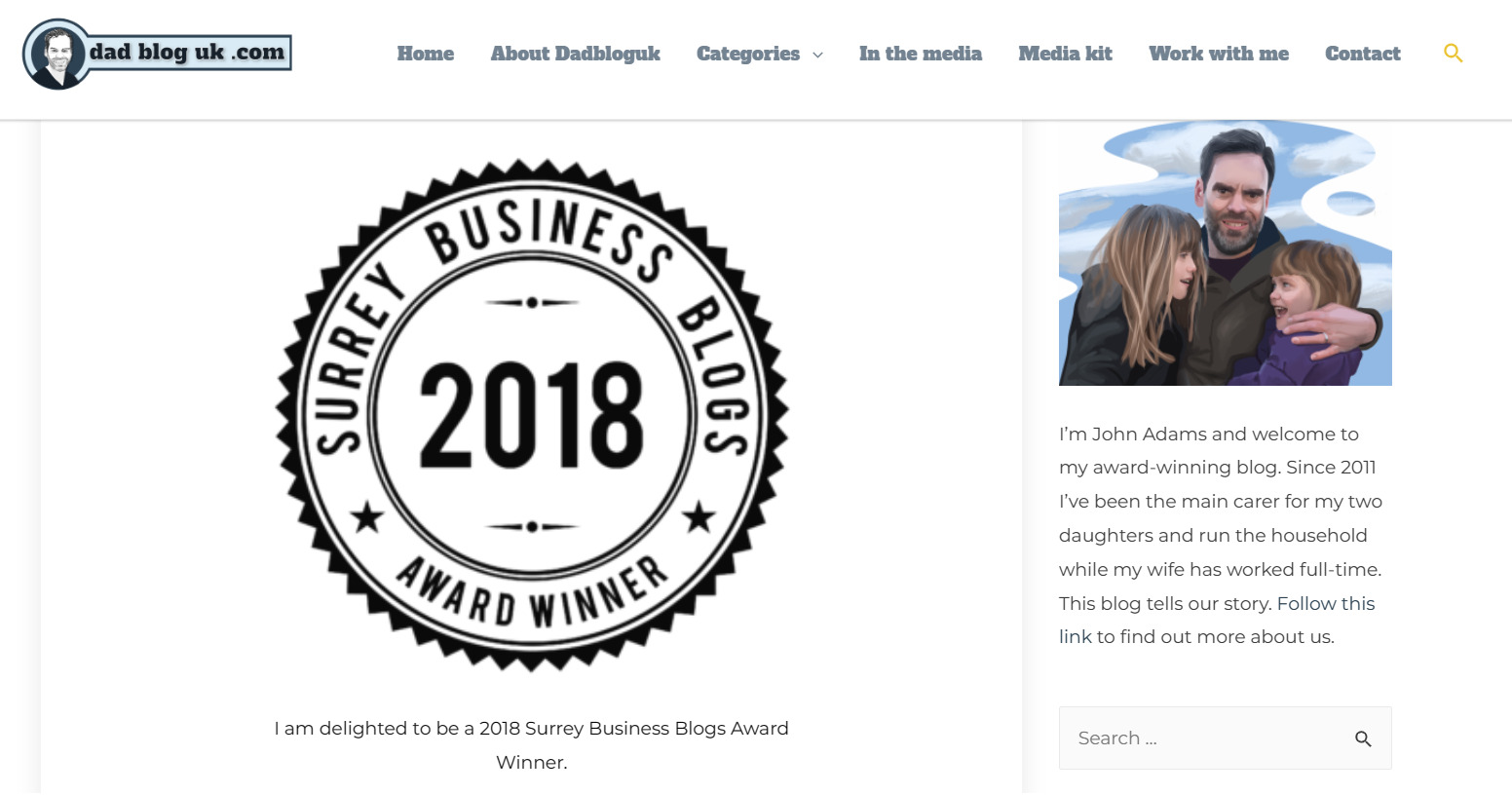
And here, you can see the link in the Backlinks report in Ahrefs’ Site Explorer:

Now that we’ve covered some of the best kinds of backlinks you can build for your site, we need to look at the types of backlinks you should avoid.
Granted, some of these types of links may give some sites short-term gains. But more often than not, these links can do significantly more harm than good. Plus, the truth of the matter is most do nothing for your site and are simply a waste of time and money.
7. Link schemes
The use of unnatural links to affect rankings in Google Search results is known as “link spam” or “link schemes.” Link schemes include both inbound links to and outbound links from your website.
Some examples of link schemes include:
- Buying and selling links.
- Excessive link exchanges.
- Requiring links as part of a Terms of Service or other agreement.
- Footers or templates with links that are distributed in mass. For example, hard-coding a link to your website into the WP Theme that you sell or give away for free.
- “Followed” links on ads.
- Over-optimized, keyword-rich links in guest posts and comments.
Private blog network (PBN)
The most popular type of link scheme is the use of private blog networks (PBNs). They’re a collection of websites made purely to link to one another and raise the website’s organic search exposure.
PBNs give the impression that a website has “earned” backlinks from other sites. You create trust signals artificially by linking to your “money” site from all the other sites in your PBN in the hopes that Google will see them as real sites and rank you better in response.
Link building with PBNs (or any link scheme) is risky and can even trigger a Google penalty.
Automated links
Using automated link building software to send links at scale to one site is not new, especially within the black hat SEO community.
However, there is an increasing trend of people packaging these links as link building services, like “foundation links,” at incredibly low prices for those with less experience looking to outsource their link building efforts.

This can be dangerous, especially if you are not in control of the automation process and don’t understand what you are getting.
These tools build a massive network of links from blogs, social bookmarks, wiki pages, etc., all pointing back to one central site. They often include layers of complex, tiered links designed to increase the amount of link equity going back to the main site.
Similar to PBNs, these links are designed to manipulate your rankings on the SERPs and are, needless to say, against Google’s webmaster guidelines.
8. Low-quality or irrelevant directory links
As mentioned above, creating business profiles on high-quality listing sites can be a great way to secure quality exposure.
However, making these at scale on any directory, regardless of the quality, is considered yet another spammy practice.
9. Low-quality forum backlinks
Spamming forums with links to your site is a pretty old-school link building technique that, in honesty, doesn’t do anything for your site.
If links are ever placed in forums, they should appear naturally as part of a genuine discussion.
This example from Hacker News shows someone advising different flight simulators as part of a discussion. This is the only way any links should be placed in forums—when used to give genuine advice or offer resources to other forum users.

10. Non-newsworthy press release links
An official statement issued to the media is known as a press release. It’s frequently used to announce anything noteworthy a business has done to get media attention. Press releases are often used to cover the following:
- Launch of a product, service, or business
- Major updates to a company, such as its rebranding, restructuring, or acquisitions
- Information about a significant crisis
Although press releases serve a great purpose when done correctly, they don’t work so well when the story you are pushing out to the press is not newsworthy. Creating press releases solely to build links is considered a spammy practice.
Of course, if your company has achieved something of merit, experienced a significant change like an acquisition, or released a new product, that’s worth sharing with the press. However, don’t send out a press release about “bring your dog to work Tuesdays” in hopes of building lots of links.

So now that we have looked at the different types of backlinks you should build and avoid, let’s look at what kinds of backlinks are valuable for your overall SEO strategy.
Backlinks coming from trusted, authoritative websites
If a website has a strong backlink profile, it is also likely perceived as an authority in its industry.
Links from high-authority sites also promote trust with search engines, sending a signal that basically says, “Hey, Forbes thinks this site is worth mentioning; check it out.”
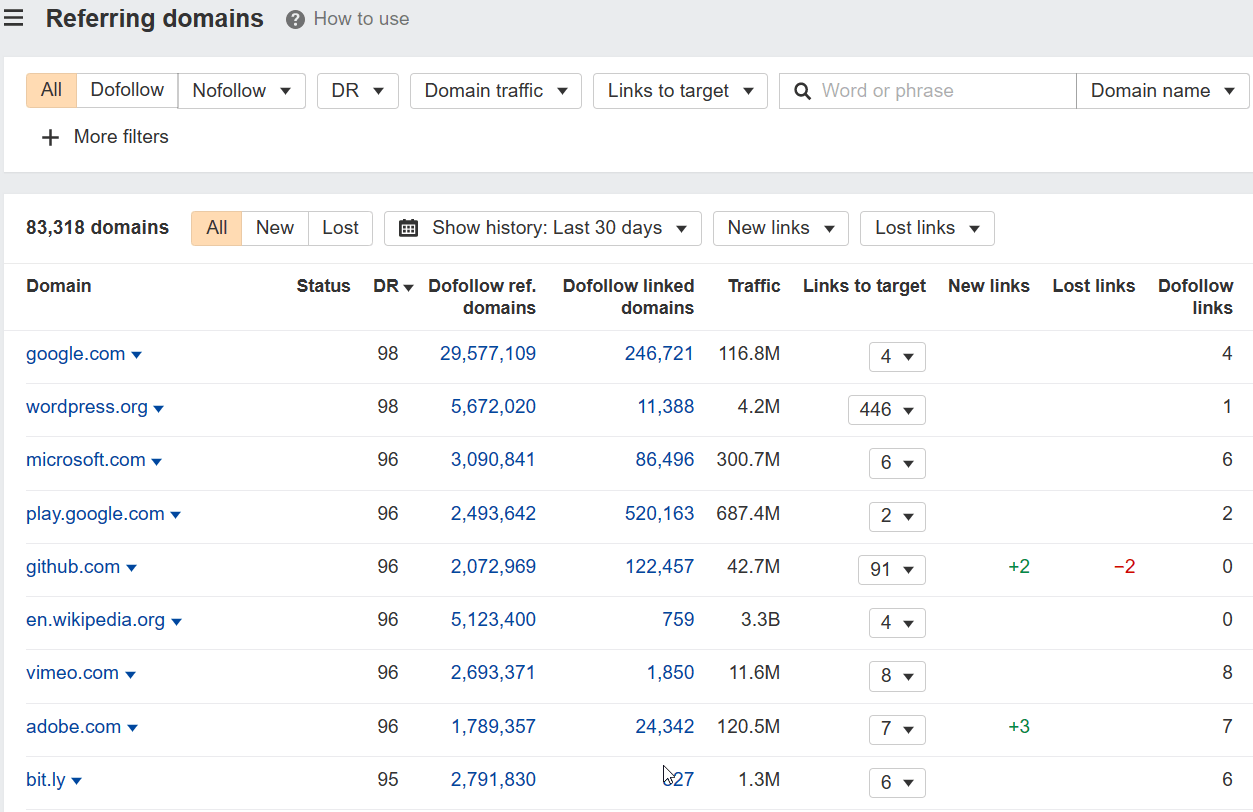
Links with anchor text including your target keywords
We wrote about the correlation between the importance of anchor texts with appropriate keywords for better rankings. To comprehend your page’s content and the keywords it should rank for, Google uses anchor text.
Here are three examples of different anchor texts pointing to the same page sourced from the Backlinks report in Ahrefs’ Site Explorer. The first two mention the target keyword “anchor text” within their anchor texts, while the third one mentions “anchor text” in the surrounding text:
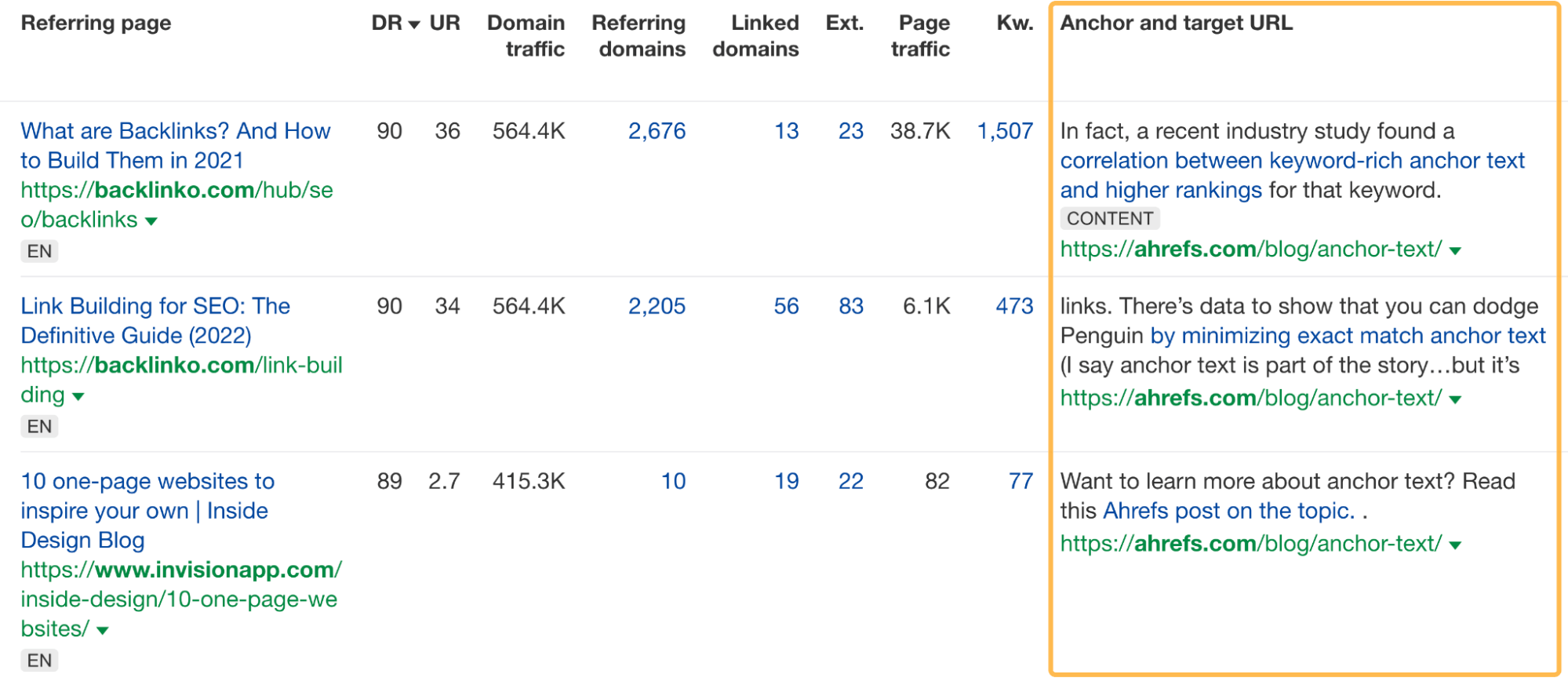
However, it is essential to remember that overuse of keywords within anchor text can be seen as manipulative by Google.
A niche-relevant page that links to yours
Links that are topically relevant to your site are essential and help Google understand your site. However, this is even more true when the page is niche-relevant.
For example, if I have a site about hiking, getting a link from a general news site’s article on hiking is good. But getting a link from another hiking site pointing to mine as an authority on hiking is better.
The more focused the website is on your niche, the better. But what ultimately matters here is the context of the link within the page and its topic.

Followed links
Followed links are the gold standard of backlinks. Everyone wants one because they can distribute link equity to your site and promote trust signals with search engines.
Any link can be considered “followed” if it doesn’t have link attributes like nofollow, sponsored, or ugc.
Each link attribute has a set purpose and provides context to search engines about the link and the page you are linking to. Unfortunately, many people misuse link attributes, sometimes purposefully.

Followed links are often used to cite sources with editorial links. For example, writing an article and quoting the results of a relevant study will link to the website where that information was found.
A current trend is for sites to use the incorrect link attribute only to reach out to you and inform you they will be happy to change the link to “followed” for a fee. This should be avoided, as it can be considered a paid link.
Backlinks from pages with strong backlink profiles
When acquiring links, we want to ensure they pass as much link equity as possible to our page. A page with a strong backlink profile of its own is generally going to provide more link equity.
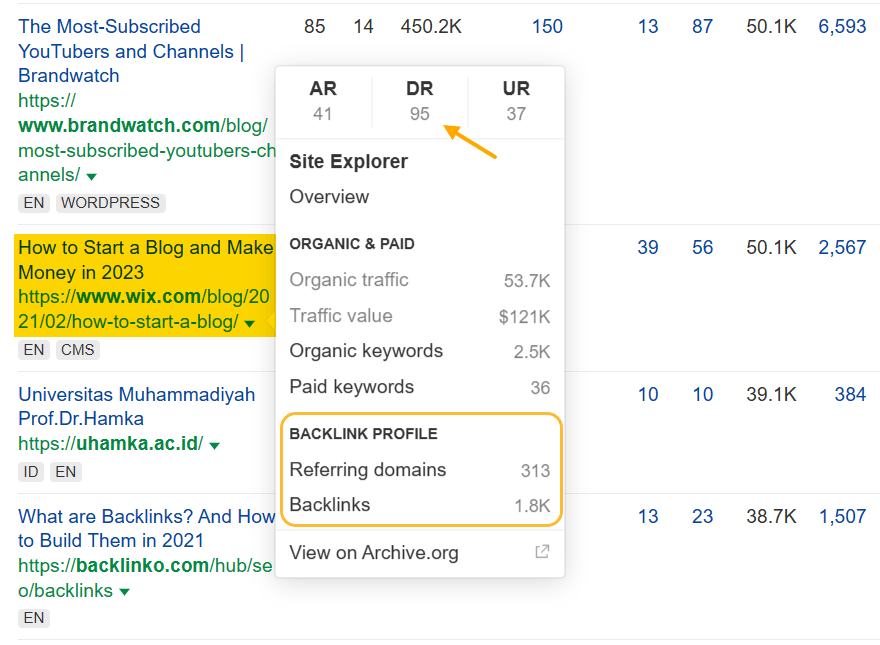
Link equity is significant because it is linked to PageRank, which is what Google has been using since forever. In other words, the more link equity a page has, the better the probability of it ranking highly.
Final thoughts
Building high-quality backlinks will always be a crucial part of SEO, and the important thing is to build the right links that will positively impact your website. Ideally, backlinks that not only move the needle but also increase brand awareness and drive referral traffic.
Have you got questions? Ping me on Twitter.
SEO
Measuring Content Impact Across The Customer Journey

Understanding the impact of your content at every touchpoint of the customer journey is essential – but that’s easier said than done. From attracting potential leads to nurturing them into loyal customers, there are many touchpoints to look into.
So how do you identify and take advantage of these opportunities for growth?
Watch this on-demand webinar and learn a comprehensive approach for measuring the value of your content initiatives, so you can optimize resource allocation for maximum impact.
You’ll learn:
- Fresh methods for measuring your content’s impact.
- Fascinating insights using first-touch attribution, and how it differs from the usual last-touch perspective.
- Ways to persuade decision-makers to invest in more content by showcasing its value convincingly.
With Bill Franklin and Oliver Tani of DAC Group, we unravel the nuances of attribution modeling, emphasizing the significance of layering first-touch and last-touch attribution within your measurement strategy.
Check out these insights to help you craft compelling content tailored to each stage, using an approach rooted in first-hand experience to ensure your content resonates.
Whether you’re a seasoned marketer or new to content measurement, this webinar promises valuable insights and actionable tactics to elevate your SEO game and optimize your content initiatives for success.
View the slides below or check out the full webinar for all the details.
SEO
How to Find and Use Competitor Keywords

Competitor keywords are the keywords your rivals rank for in Google’s search results. They may rank organically or pay for Google Ads to rank in the paid results.
Knowing your competitors’ keywords is the easiest form of keyword research. If your competitors rank for or target particular keywords, it might be worth it for you to target them, too.
There is no way to see your competitors’ keywords without a tool like Ahrefs, which has a database of keywords and the sites that rank for them. As far as we know, Ahrefs has the biggest database of these keywords.
How to find all the keywords your competitor ranks for
- Go to Ahrefs’ Site Explorer
- Enter your competitor’s domain
- Go to the Organic keywords report
The report is sorted by traffic to show you the keywords sending your competitor the most visits. For example, Mailchimp gets most of its organic traffic from the keyword “mailchimp.”


Since you’re unlikely to rank for your competitor’s brand, you might want to exclude branded keywords from the report. You can do this by adding a Keyword > Doesn’t contain filter. In this example, we’ll filter out keywords containing “mailchimp” or any potential misspellings:


If you’re a new brand competing with one that’s established, you might also want to look for popular low-difficulty keywords. You can do this by setting the Volume filter to a minimum of 500 and the KD filter to a maximum of 10.


How to find keywords your competitor ranks for, but you don’t
- Go to Competitive Analysis
- Enter your domain in the This target doesn’t rank for section
- Enter your competitor’s domain in the But these competitors do section


Hit “Show keyword opportunities,” and you’ll see all the keywords your competitor ranks for, but you don’t.


You can also add a Volume and KD filter to find popular, low-difficulty keywords in this report.


How to find keywords multiple competitors rank for, but you don’t
- Go to Competitive Analysis
- Enter your domain in the This target doesn’t rank for section
- Enter the domains of multiple competitors in the But these competitors do section


You’ll see all the keywords that at least one of these competitors ranks for, but you don’t.


You can also narrow the list down to keywords that all competitors rank for. Click on the Competitors’ positions filter and choose All 3 competitors:


- Go to Ahrefs’ Site Explorer
- Enter your competitor’s domain
- Go to the Paid keywords report


This report shows you the keywords your competitors are targeting via Google Ads.
Since your competitor is paying for traffic from these keywords, it may indicate that they’re profitable for them—and could be for you, too.
You know what keywords your competitors are ranking for or bidding on. But what do you do with them? There are basically three options.
1. Create pages to target these keywords
You can only rank for keywords if you have content about them. So, the most straightforward thing you can do for competitors’ keywords you want to rank for is to create pages to target them.
However, before you do this, it’s worth clustering your competitor’s keywords by Parent Topic. This will group keywords that mean the same or similar things so you can target them all with one page.
Here’s how to do that:
- Export your competitor’s keywords, either from the Organic Keywords or Content Gap report
- Paste them into Keywords Explorer
- Click the “Clusters by Parent Topic” tab


For example, MailChimp ranks for keywords like “what is digital marketing” and “digital marketing definition.” These and many others get clustered under the Parent Topic of “digital marketing” because people searching for them are all looking for the same thing: a definition of digital marketing. You only need to create one page to potentially rank for all these keywords.


2. Optimize existing content by filling subtopics
You don’t always need to create new content to rank for competitors’ keywords. Sometimes, you can optimize the content you already have to rank for them.
How do you know which keywords you can do this for? Try this:
- Export your competitor’s keywords
- Paste them into Keywords Explorer
- Click the “Clusters by Parent Topic” tab
- Look for Parent Topics you already have content about
For example, if we analyze our competitor, we can see that seven keywords they rank for fall under the Parent Topic of “press release template.”


If we search our site, we see that we already have a page about this topic.


If we click the caret and check the keywords in the cluster, we see keywords like “press release example” and “press release format.”


To rank for the keywords in the cluster, we can probably optimize the page we already have by adding sections about the subtopics of “press release examples” and “press release format.”
3. Target these keywords with Google Ads
Paid keywords are the simplest—look through the report and see if there are any relevant keywords you might want to target, too.
For example, Mailchimp is bidding for the keyword “how to create a newsletter.”


If you’re ConvertKit, you may also want to target this keyword since it’s relevant.
If you decide to target the same keyword via Google Ads, you can hover over the magnifying glass to see the ads your competitor is using.


You can also see the landing page your competitor directs ad traffic to under the URL column.


Learn more
Check out more tutorials on how to do competitor keyword analysis:
SEO
Google Confirms Links Are Not That Important

Google’s Gary Illyes confirmed at a recent search marketing conference that Google needs very few links, adding to the growing body of evidence that publishers need to focus on other factors. Gary tweeted confirmation that he indeed say those words.
Background Of Links For Ranking
Links were discovered in the late 1990’s to be a good signal for search engines to use for validating how authoritative a website is and then Google discovered soon after that anchor text could be used to provide semantic signals about what a webpage was about.
One of the most important research papers was Authoritative Sources in a Hyperlinked Environment by Jon M. Kleinberg, published around 1998 (link to research paper at the end of the article). The main discovery of this research paper is that there is too many web pages and there was no objective way to filter search results for quality in order to rank web pages for a subjective idea of relevance.
The author of the research paper discovered that links could be used as an objective filter for authoritativeness.
Kleinberg wrote:
“To provide effective search methods under these conditions, one needs a way to filter, from among a huge collection of relevant pages, a small set of the most “authoritative” or ‘definitive’ ones.”
This is the most influential research paper on links because it kick-started more research on ways to use links beyond as an authority metric but as a subjective metric for relevance.
Objective is something factual. Subjective is something that’s closer to an opinion. The founders of Google discovered how to use the subjective opinions of the Internet as a relevance metric for what to rank in the search results.
What Larry Page and Sergey Brin discovered and shared in their research paper (The Anatomy of a Large-Scale Hypertextual Web Search Engine – link at end of this article) was that it was possible to harness the power of anchor text to determine the subjective opinion of relevance from actual humans. It was essentially crowdsourcing the opinions of millions of website expressed through the link structure between each webpage.
What Did Gary Illyes Say About Links In 2024?
At a recent search conference in Bulgaria, Google’s Gary Illyes made a comment about how Google doesn’t really need that many links and how Google has made links less important.
Patrick Stox tweeted about what he heard at the search conference:
” ‘We need very few links to rank pages… Over the years we’ve made links less important.’ @methode #serpconf2024″
Google’s Gary Illyes tweeted a confirmation of that statement:
“I shouldn’t have said that… I definitely shouldn’t have said that”
Why Links Matter Less
The initial state of anchor text when Google first used links for ranking purposes was absolutely non-spammy, which is why it was so useful. Hyperlinks were primarily used as a way to send traffic from one website to another website.
But by 2004 or 2005 Google was using statistical analysis to detect manipulated links, then around 2004 “powered-by” links in website footers stopped passing anchor text value, and by 2006 links close to the words “advertising” stopped passing link value, links from directories stopped passing ranking value and by 2012 Google deployed a massive link algorithm called Penguin that destroyed the rankings of likely millions of websites, many of which were using guest posting.
The link signal eventually became so bad that Google decided in 2019 to selectively use nofollow links for ranking purposes. Google’s Gary Illyes confirmed that the change to nofollow was made because of the link signal.
Google Explicitly Confirms That Links Matter Less
In 2023 Google’s Gary Illyes shared at a PubCon Austin that links were not even in the top 3 of ranking factors. Then in March 2024, coinciding with the March 2024 Core Algorithm Update, Google updated their spam policies documentation to downplay the importance of links for ranking purposes.
The documentation previously said:
“Google uses links as an important factor in determining the relevancy of web pages.”
The update to the documentation that mentioned links was updated to remove the word important.
Links are not just listed as just another factor:
“Google uses links as a factor in determining the relevancy of web pages.”
At the beginning of April Google’s John Mueller advised that there are more useful SEO activities to engage on than links.
Mueller explained:
“There are more important things for websites nowadays, and over-focusing on links will often result in you wasting your time doing things that don’t make your website better overall”
Finally, Gary Illyes explicitly said that Google needs very few links to rank webpages and confirmed it.
I shouldn’t have said that… I definitely shouldn’t have said that
— Gary 鯨理/경리 Illyes (so official, trust me) (@methode) April 19, 2024
Why Google Doesn’t Need Links
The reason why Google doesn’t need many links is likely because of the extent of AI and natural language undertanding that Google uses in their algorithms. Google must be highly confident in its algorithm to be able to explicitly say that they don’t need it.
Way back when Google implemented the nofollow into the algorithm there were many link builders who sold comment spam links who continued to lie that comment spam still worked. As someone who started link building at the very beginning of modern SEO (I was the moderator of the link building forum at the #1 SEO forum of that time), I can say with confidence that links have stopped playing much of a role in rankings beginning several years ago, which is why I stopped about five or six years ago.
Read the research papers
Authoritative Sources in a Hyperlinked Environment – Jon M. Kleinberg (PDF)
The Anatomy of a Large-Scale Hypertextual Web Search Engine
Featured Image by Shutterstock/RYO Alexandre
-

 PPC5 days ago
PPC5 days ago19 Best SEO Tools in 2024 (For Every Use Case)
-

 MARKETING6 days ago
MARKETING6 days agoStreamlining Processes for Increased Efficiency and Results
-
SEARCHENGINES6 days ago
Daily Search Forum Recap: April 17, 2024
-

 PPC7 days ago
PPC7 days ago97 Marvelous May Content Ideas for Blog Posts, Videos, & More
-

 SEO6 days ago
SEO6 days agoAn In-Depth Guide And Best Practices For Mobile SEO
-
SEARCHENGINES5 days ago
Daily Search Forum Recap: April 18, 2024
-

 MARKETING6 days ago
MARKETING6 days agoEcommerce evolution: Blurring the lines between B2B and B2C
-
SEARCHENGINES4 days ago
Daily Search Forum Recap: April 19, 2024
















You must be logged in to post a comment Login